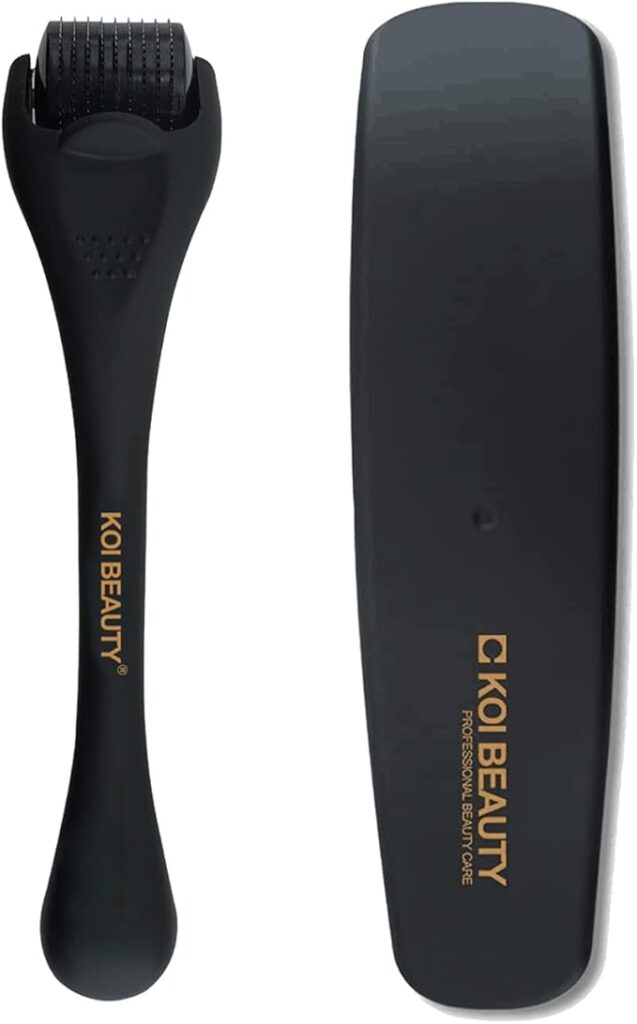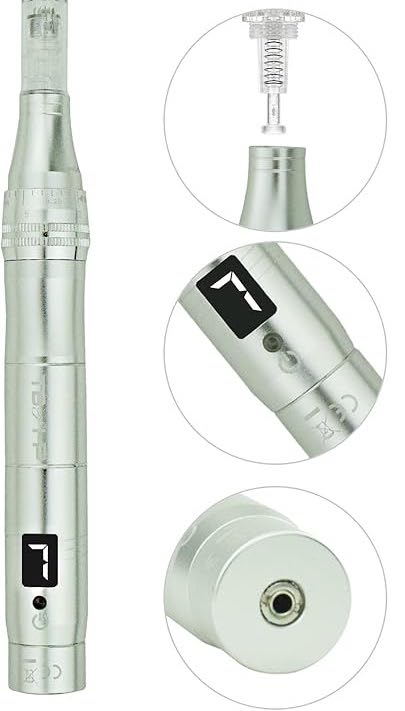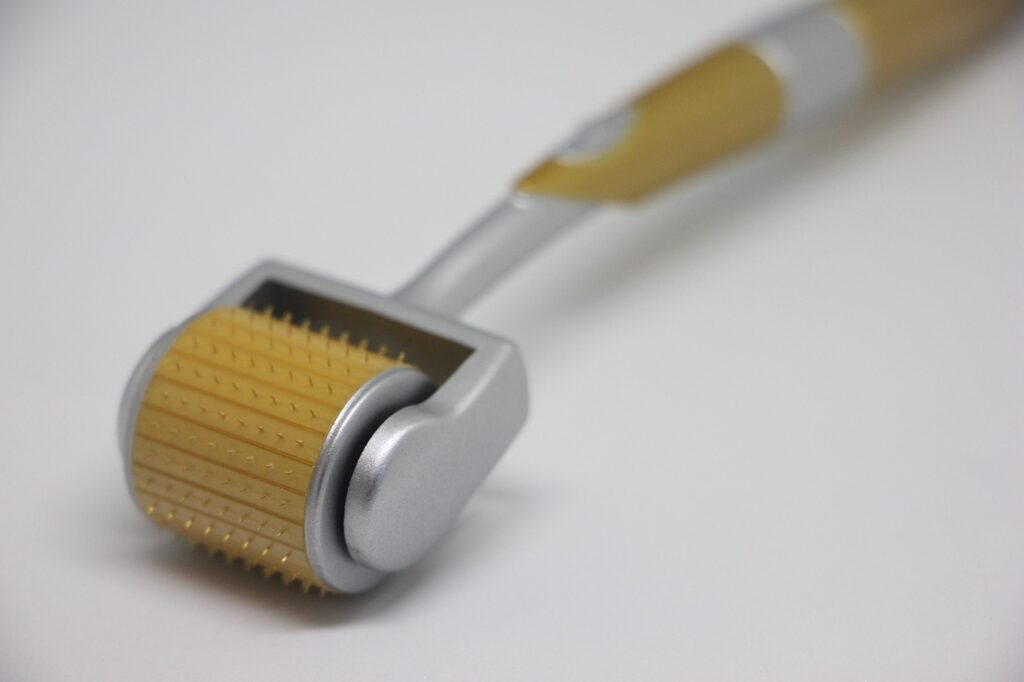A micro rebellion is brewing in the world of hair loss, and the weapons of choice are surprisingly small: dermarollers and derma pens. These tiny tools are challenging the status quo, offering a non-invasive, potentially powerful approach to hair regrowth. But before you enlist in this fight club, let’s explore the science behind the microneedles and see if a dermaroller vs dermapen can truly be your hair’s best friend.
Micro-needling: A Microscopic Mission
Imagine this: tiny needles creating microscopic pinpricks on your scalp. Sounds intense, right? That’s the basic idea behind microneedling devices like dermarollers and derma pens. These handheld devices have hundreds of fine needles that, when rolled over your scalp, create controlled injuries. Don’t panic! These “injuries” are actually a good thing. They trigger your body’s natural healing response, increasing blood flow and collagen production in the treated area. This, in theory, can create a more favorable environment for hair growth.
Let’s Talk Science :
The science behind micro-needling and hair growth is still developing. Studies show some promise. Here’s the gist:
- Increased Blood Flow: The tiny needles are thought to improve blood circulation to the scalp, which could nourish hair follicles and promote growth.
- Collagen Boost: Dermarolling might stimulate collagen production, a protein essential for healthy hair growth.
- Enhanced Absorption: Microneedling may help topical hair loss treatments penetrate deeper into the scalp, potentially making them more effective.
So, Does It Work for Hair Loss?
The jury’s still out on a definitive answer. Some studies suggest dermarollers can be helpful, especially when combined with other hair loss treatments like minoxidil (Rogaine). (Side note, if you want to read more about this hair growth wonder ingredient, check this out) However, the effectiveness can vary depending on factors like the severity of hair loss, needle size, and treatment frequency. Needles between 0.5mm and 1.0mm are generally recommended for stimulating hair growth. For addressing deeper concerns like severe hair loss or scalp scarring, a dermatologist might recommend a professional treatment with needles exceeding 1.0mm (use at home with caution). Individuals with sensitive scalps should start with shorter needles (0.25mm to 0.5mm) to minimize irritation.
Treatment Frequency:
Generally, aim for 1-2 times per week, allowing your scalp sufficient time to heal between sessions. Needle Size Matters. Longer needles (over 0.5mm) typically require less frequent use (every 10-14 days) compared to shorter needles.
Here’s a quick breakdown:
| Needle Size (mm) | Desired Outcome | Frequency | Best For |
|---|---|---|---|
| 0.25-0.5 | Stimulate Growth, Sensitive Scalps | 1-2 times/week | Sensitive scalps, beginners |
| 0.5-1.0 | Stimulate Growth | 1-2 times/week | Most users |
| >1.0 (Professional) | Address Deeper Concerns | Every 10-14 days | Under dermatologist supervision |
Dermaroller vs. Dermapen: Picking Your Weapon
Dermaroller
Pros:
- Cost-Effective: Dermarollers are generally budget-friendly, making them an attractive option for cost-conscious warriors.Wide Availability: Easy to find online and in stores, dermarollers are readily available for quick deployment.
Simple to Use: The rolling mechanism requires minimal technique, making them user-friendly for beginner
Cons:
- Less Precise: The needles on a dermaroller may not penetrate the scalp at a uniform depth, potentially leading to inconsistent results.
- Pressure Point: Dermarollers might require more pressure to achieve effective microneedling, which can irritate sensitive scalps.
- Uneven Coverage: The rolling motion can lead to missed spots or uneven penetration, compromising treatment effectiveness.
- Hygiene Hurdle: Due to their design, dermarollers can be difficult to thoroughly disinfect, raising hygiene concerns.
Here’s our top pick for Dermaroller

KOI BEAUTY Derma Roller Hair Growth for Men
- Microneedling Roller 0.5m with 540 Titanium Needles
- Dermaroller for Face, body, scalp suitable for Home Use
- The micro needle roller comes with a sealed individual case, making it safe and hygienic
- Cost Effective & easy to use
Dermapens
Pros:
Precision: Dermapens offer adjustable needles, ensuring consistent penetration depth for targeted results.
Gentler on Sensitive Scalps: Less pressure is needed with dermapens, minimizing irritation for those with sensitive scalps.
Targeted Treatment: The pen design allows for precise targeting of specific areas with hair loss concerns.
Hygiene: Disposable needles on dermapens minimize the risk of infection, promoting a more hygienic approach.
Cons:
- Price Point: Dermapens are generally more expensive than dermarollers, requiring a higher initial investment.
- Learning Curve: Using a dermapen effectively requires some practice and mastering the proper technique.
- Durability Dilemma: The moving parts of a dermapen may need more frequent replacement compared to the simpler design of a dermaroller.
Before You Roll:
- Talk to your doctor: Micro-needling isn’t for everyone. It’s important to consult a doctor before using one, especially if you have any existing scalp conditions.
- Cleanliness is Key: Always sanitize your micro-needling device before and after use to avoid infection.
The Dermaroller vs Dermapen Rolling Ritual:
- Prep Your Scalp: Wash your scalp with a gentle shampoo and dry it completely.
- Roll with Caution: Start with light pressure and gently roll the dermaroller over the targeted areas of your scalp in different directions for a few minutes. Avoid rolling over moles or blemishes.
- Start Microneedling: Gently glide the dermapen across your scalp in vertical, horizontal, and diagonal motions. Apply light, even pressure to ensure even penetration.
- Focus on Target Areas: Pay particular attention to areas with thinning hair or receding hairline.
- Soothe and Moisturize: After rolling, apply a calming moisturizer to your scalp.
- Don’t Overdo It: Experts generally recommend using a dermaroller 1-2 times a week to avoid damaging your scalp.
Important Note: This is a general guide. Always follow the specific instructions that come with your dermaroller.
Micro-needling: What to Expect
- Don’t expect overnight results. Consistent use for several months might be needed to see any noticeable improvement.
- You might experience some redness or minor bleeding after using a dermaroller. This is usually temporary and should subside within a day.
- Like any tool, dermarollers can come with risks if not used properly, including infection and scarring.
Micro-needling Do’s and Don’ts:
Do:
- Start slow. Begin with shorter needle lengths (0.25mm to 0.5mm) and gradually increase if tolerated.
- Be gentle. Don’t apply excessive pressure while rolling.
- Replace regularly. Dermarollers lose effectiveness as the needles become dull. Replace them every few months.
Don’t:
- Sharing is caring bt not when it comes to your dermaroller. Do not share your roller. It’s a personal hygiene item to avoid spreading bacteria.
- Don’t use it on irritated skin and wait until any existing scalp conditions heal before rolling.
- Go overboard. Stick to the recommended frequency and pressure
Here’s our top pick for Dermapen

TBPHP Dermapen M1
- Electric & Wireless
- LCD Screen with 12 Replacement Cartridges (Silver)
- The one-click operation is so easy that even beginners can master it quickly.
- Cost effective & easy to use
Beyond the Dermaroller vs Dermapen:
Dermarolling might be a weapon in your hair loss arsenal, but it’s not the only one. Here are some additional strategies to consider for a multi-pronged attack:
Scalp Care:
- Shampoo: Ditch harsh shampoos that strip your scalp of natural oils. Look for gentle, scalp-nourishing formulas with ingredients like biotin and saw palmetto.
- Exfoliate Occasionally: Regularly exfoliating your scalp removes dead skin cells that can clog hair follicles. Use a gentle scrub or scalp massager to avoid irritation.
- Massage Magic: A daily scalp massage can improve blood circulation, potentially promoting hair growth. Spend a few minutes gently massaging your scalp with your fingertips.
Fueling Your Hair from Within:
- Diet Dos and Don’ts: Eat a balanced diet rich in protein, iron, vitamins A, C, D, and E. These nutrients are essential for healthy hair growth. Limit processed foods and sugary drinks.
- Hydration: Aim to drink plenty of water throughout the day. Dehydration can contribute to hair loss.
- Supplement Savvy: Consider talking to your doctor about hair loss supplements like biotin or zinc. However, remember, supplements are not a magic bullet and should be used alongside other strategies.
Manage that Stress:
Chronic stress can wreak havoc on your hair growth. Practice stress-management techniques like meditation, yoga, or deep breathing exercises.
Sleep Undercover: Aim for 7-8 hours of quality sleep each night. Sleep deprivation can disrupt hair growth cycles.
Talk to Your Doctor:
If you’re experiencing significant hair loss, it’s crucial to consult a dermatologist or trichologist (a hair loss specialist). They can diagnose the underlying cause of your hair loss and recommend a personalized treatment plan. This might include medications like minoxidil or finasteride, or even hair transplant procedures.
The Final Roll Call:
Micro-needling can be a potential tool for hair growth, but they’re not a guaranteed solution. Remember, consistency is key. Combine micro-needling with a healthy lifestyle, proper scalp care, and potentially other hair loss treatments for a more holistic approach.



